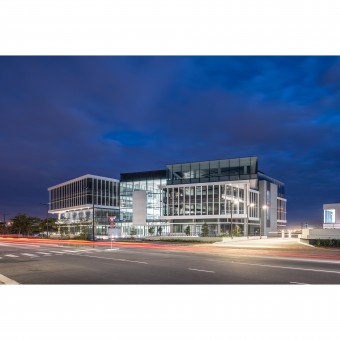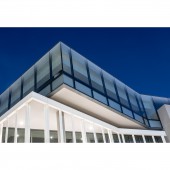
| THE AWARD |
| CATEGORIES |
| REGISTRATION |
| SUBMIT YOUR WORK |
| ENTRY INSTRUCTIONS |
| TERMS & CONDITIONS |
| PUBLICATIONS |
| DATES & FEES |
| METHODOLOGY |
| CONTACT |
| WINNERS |
| PRESS ROOM |
| GET INVOLVED |
| DESIGN PRIZE |
| DESIGN STORE |
| THE AWARD | JURY | CATEGORIES | REGISTRATION | PRESS | WINNERS | PUBLICATIONS | ENTRY INSTRUCTIONS |
Sable Park Commercial Development by dhk Architects |
Home > Winners > Design #71925 >Interview |
 |
|
FS: What is the main principle, idea and inspiration behind your design?
DA: The buildings' composition was inspired by shuffling forms that operate independently and adapt to their immediate surroundings. On an abstract level, the spaces are duplicated, and the volumes are inverted. This simple application was the singular method to the complexity of the resultant macro-articulation which forms a setting for a series of tableaux with an iconic mountain backdrop. In effect, this complex was set out in scenes that take inspiration from aspects of cinematography and film.
FS: What has been your main focus in designing this work? Especially what did you want to achieve?
DA: Originally dubbed; the ‘macro-chip shuffle’, the building was intentionally designed to appear as a single large complex and simultaneously as four small independent volumes in symphony – depending on where it is viewed from. The four volumes are further broken down into thirds; a double height layered mass and a single height crystalline cube. Each of these thirds shift and jump on the horizontal and vertical plain to achieve maximum views and optimal orientation.
FS: Why did you design this particular concept? Was this design commissioned or did you decide to pursuit an inspiration?
DA: Rabie Property Group required a design that exuded a contemporary modern vernacular. As the buildings front Sable Road, a prominent gateway into Century City, the site offered high visibility and the ability to provide uninterrupted panoramic views of Table Mountain and Table Bay.
FS: What made you design this particular type of work?
DA: Rabie Property Group set out to create an iconic front face for their blossoming mixed-use precinct. Sitting on the edge of Sable Road, a prominent entry point into Century City, the development forms a gateway landmark for ‘Bridgeways Precinct’. This new neighbourhood comprises a mix of lifestyle and commercial functions, creating a 24hour atmosphere and a solid context for new office and residential complexes.
FS: Who is the target customer for his design?
DA: Corporate companies to lease the offices.
FS: How did you come up with the name for this design? What does it mean?
DA: The name of the development is directly linked to its location. Sable Park is located on a site situated on the South-West end of the Bridgeways Precinct. It is bounded by Sable Road to the south, Bridgeways Road to the north and Axis Lane to the west, with a direct physical and visual link to the N1 highway. Situated at the southern edge of the precinct, it boasts unobstructed panoramic views of Table Mountain.
FS: What is the most unique aspect of your design?
DA: A large part of the building’s concept was manifested in its structure. Creating distinct floating boxes that veer off and cantilever beyond one another was one of the biggest challenges. The engineers and designers worked closely together right from early concept phase to put the pieces in place to achieve this.
FS: Who did you collaborate with for this design? Did you work with people with technical / specialized skills?
DA: Developer: Rabie Property Group Architects: dhk architects (Henry Abosi, Steve Peters, Wardah Razak, Lucienne Myburgh) Project Manager: Cogent Development Management Structural Engineers: Aurecon Mechanical Engineers: BVI Engineering Electrical Engineers: QDP Light and Electrical Design (Pty) Ltd Façade Engineers: LH Consulting Engineers Environmental: Ecosense Environmental Consultants Landscaping: Planning Partners Quantity Surveyor: RLB / Pentad Quantity Surveyors Main Contractor: WBHO Fire Consultant: Solution Station Consulting Engineering Sustainability Consultant: PJ Carew Consulting Land Surveyor: David Hellig & Abrahamse Interior Designer: dhk thinkspace Lighting Consultant: QDP Lighting & Electrical Design (Pty) Ltd Lift Consultant / Wet Services: Ekcon Engineers
FS: What is the role of technology in this particular design?
DA: Sable Park has achieved a 5-star Green Star SA Design office certification, as administered by the Green Building Council of SA (GBCSA) and is currently targeting the equal As-Built certification. The overall strategic sustainability focus, throughout the design process, was to incorporate the green principles of Bridgeways Precinct, within Century City. To create a lower environmental foot print without compromising comfort, various approaches have been adopted. The double-glazed external building envelope was designed to allow increased levels of daylight to penetrate the floor plate while at the same time provide remarkable external views towards Table Mountain. All the shopfronts in the building are set back 700mm and protected by an outer brise soleil to allow for passive solar control. Further to this a layer of Internal blinds on all windows contribute to glare reduction. The façade is therefore able to contribute to the enhancement of the occupant’s comfort and productivity. The maximised duration of daylight, along with LED light fittings paired with occupancy and daylight sensors, reduces electrical consumption by lowering internal lighting requirements. Externally, lighting has been designed to avoid light pollution into the sky. An energy sub-metering system, which tracks building energy usage, thereby promoting optimum performance, has also been applied. Water efficient fittings have been installed and treated recycled water is used for toilet flushing, as well as in the HVAC Slim Line Cooling Towers. Smart water meters allow the user to understand and therefore reduce unnecessary municipal water consumption. Low volatile organic compound finishes have been used throughout, providing a comfortable and healthy indoor environment. Carbon Dioxide Monitoring and control sensors ensure that the building occupants always breathe clean air.
FS: What are some of the challenges you faced during the design/realization of your concept?
DA: To achieve the shadow gap, a complex double slab component was introduced. The gap is achieved by a perimeter concrete downstand beam projecting into the ceiling void below, and extending outwards to form a protruding flange, or architectural slab, to echo the plan of the floor slab below. The reality of this component was questionable at times, but the desired result was achieved. The ‘shadow gap’ occurs at every instance where the two distinct boxes come into contact; which is just below the second floor, when the layered double height mass is on top, or just below the third floor, when the glass cube is on top.
FS: Thank you for providing us with this opportunity to interview you.
A' Design Award and Competitions grants rights to press members and bloggers to use parts of this interview. This interview is provided as it is; DesignPRWire and A' Design Award and Competitions cannot be held responsible for the answers given by participating designers.
| SOCIAL |
| + Add to Likes / Favorites | Send to My Email | Comment | View Press-Release |





